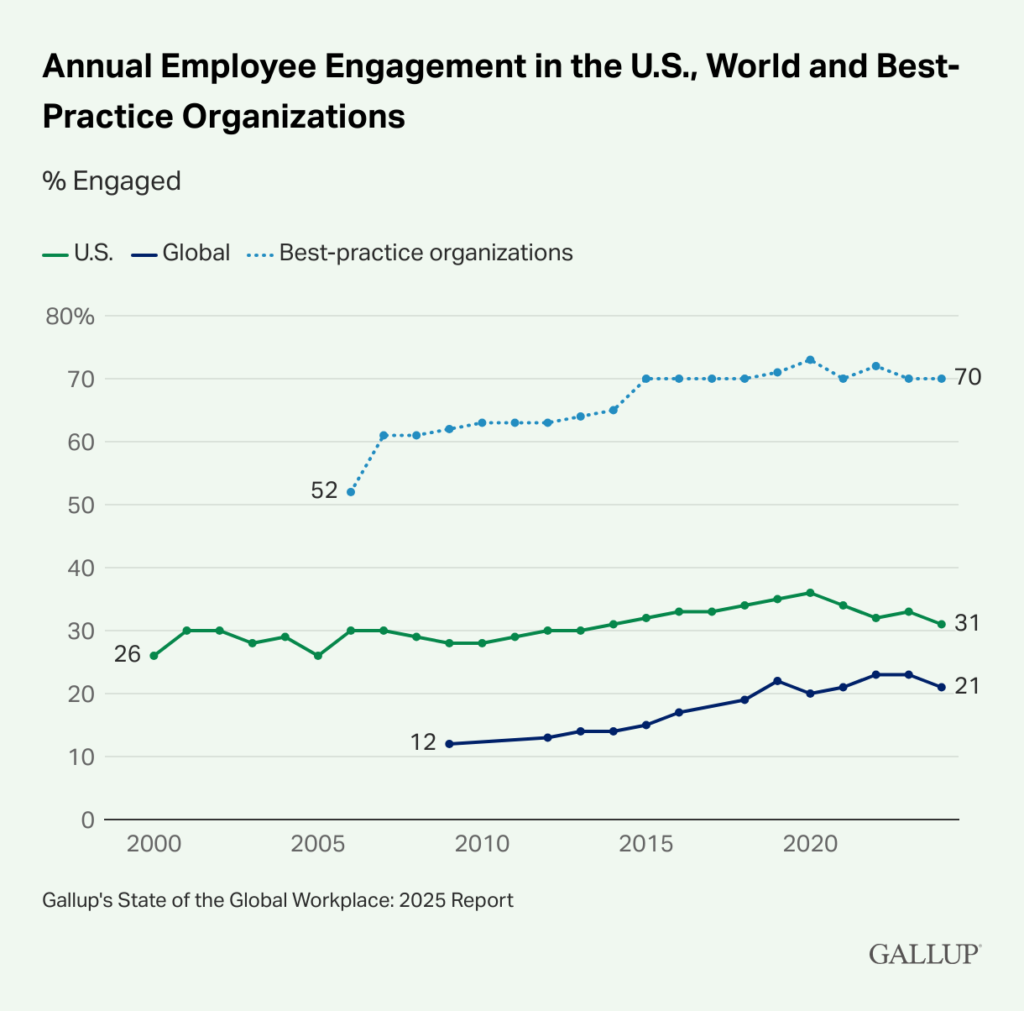The data is clear. The cost is real. And the solution is long overdue.
In August last year, I wrote about a quiet crisis. In Future-Proofing Global Organisations: Building Effective Leadership Pipelines, I shared a concern I’d heard echoed by HR leaders across sectors: we’re promoting people into leadership roles before they’re ready—and without the development they need to succeed.
Now, Gallup has put a price tag on that decision: $438 billion.
That’s what falling employee engagement cost the global economy in 2024.
And it’s not abstract. It’s avoidable.
Because disengagement isn’t caused by laziness. It’s caused by underprepared managers being set up to fail.
I know what happens when you invest early
At 20, I was headhunted by a company that saw leadership potential in me—before I saw it in myself. I’d planned to join the army. Office life wasn’t the plan.
But they didn’t just offer me a job. They invested in me.
With training in management, communication, presentation skills, human skills—the works. Before I managed anyone, I was equipped to lead.
That company went on to become the biggest in its industry. And that early investment shaped my entire view of leadership: grow people early, or pay for it later.
I saw the other side running an agency
Years later, I set up and ran an international digital agency for 15 years. And anyone who’s run one will know: it’s a constant balancing act.
- Right team size, right timing
- Hiring ahead, while keeping margins tight
- Managing client load, profit, and culture—simultaneously
But one thing I never compromised on?
Training and wellbeing.
Because it wasn’t just about delivery. It was about developing the next generation of digital leaders. We grew account managers and strategists into confident, capable, high-performing digital superstars—aligned with our values and brand purpose.
That investment wasn’t a nice-to-have. It was the reason the agency succeeded. I truly believe that you can’t build a high-performing team on low-support leadership.
Culture wasn’t posters—it was what we lived
We had team members in the office and others based abroad. Hybrid, long before it was mainstream.
Every single month, I had a one-to-one with every person on the team. We called it Walking Words (this was on top of their manager one to ones).
If we were in the same city, we’d walk and talk. If they were abroad, we’d put on headphones and FaceTime while walking.
No slides. No KPIs. Just time to talk. Properly.
It gave space for honesty. Sparked new ideas. Flagged small concerns before they became big problems. And built the kind of trust that creates real loyalty.
If I went back to day one, I’d do it again in a heartbeat.
I’d often receive comments from other leaders, suppliers, external trainers, mentors and so on, saying that they’d never a company like us. We were different and that was intentional – to be a place with purpose and values that created a place that thrived.
Because a team without training, engagement and wellbeing? That’s a pretty sad place. And it won’t perform—no matter how slick your systems are.
It still runs today, with the team and I know that the values and purpose of that agency are due to team investment at its heart.
Gallup’s data confirms what leaders feel
The State of the Global Workplace 2025 report is unambiguous:
- Global engagement dropped to 21%
- Manager engagement fell from 30% to 27%
- Female manager engagement fell seven points
- Managers under 35 fell five points
- Only 44% of managers have ever received formal training for their role
In other words: more than half of the world’s managers are leading without the tools to succeed. And we’re surprised engagement is falling?
And this isn’t just about performance—it’s about wellbeing
Gallup found:
- Managers who are trained are 50% more likely to be thriving
- Coaching-based training improves manager performance by 20–28%
- Their teams see engagement rise by up to 18%
- And the impact lasts up to 18 months after the training ends
Engaged leaders build engaged teams.
And engaged teams perform better, stay longer, and feel better. It’s that simple.
In a world shaped by AI and change, this matters more—not less
Gallup also warns of “seismic change” from AI, automation and digital disruption.
But here’s the thing: AI won’t build trust. Or coach someone through self-doubt. Or have a quiet word when someone’s off their game.
That’s the manager’s job.
And right now, too many managers are undertrained, overstretched and under water.
You want your organisation to thrive in a hybrid, AI-enabled, fast-moving world? Start with leadership capability.
The six steps still hold
In last year’s piece, I laid out six strategies for building strong leadership pipelines:
- Spot talent early—and invest before promotion
- Align development to strategy—not just job titles
- Use tech to scale—but keep it live and human
- Make inclusive leadership core—not a bolt-on
- Build succession readiness—not succession panic
- Embed learning as culture—not content
They still stand. But now they’re more urgent than ever.
Final word
If engagement is slipping in your business, start here:
- Are your managers equipped?
- Are they supported?
- Are they thriving—or just surviving?
- Can they lead confidently through AI, hybrid, pressure and pace?
Because if the answer’s no, then that $438 billion gap isn’t just a statistic.
It’s a mirror.
And it’s not too late to fix it.
You can read the full Gallup report here : Global Engagement Falls for the Second Time Since 2009
Cognitive Union is a progressive, boutique learning and performance consultancy. We work with forward-thinking businesses. Transforming their people. Shaping their culture. Helping them embrace change and take on the world. Find this blog useful? Sign up to our email newsletter (bottom of this page), where you can receive articles like this and other insights (not publicly published), and you can also follow us on LinkedIn.

